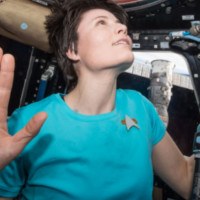
"In a few words... from earth to space", this is the title of the lecture Samantha Cristoforetti will give on the occasion of the first of the "Umberto Eco Lectures" at the International Center for Humanities "Umberto Eco" of the University of Bologna. The lecture will take place on Tuesday February 18 at 17 in Santa Lucia Great Hall (Via Castiglione 36 - Bologna); access is free but subject to seats availability.
After Rector Francesco Ubertini's institutional greetings, Patrizia Violi, former director of "Umberto Eco" Center, and Costantino Marmo, current director of the Center, will briefly present their guest. Then, Samantha Cristoforetti will take the audience on a journey to space, exploring the space she lived in, explaining her long transformation into an “extraterrestrial human being” during her 200 days on the International Space Station. Samantha will share her experience as astronaut and her take on the meaning of words like speed, wait, beauty, transformation, weight, lightness, distance and time.
Umberto Eco started this tradition of guest key-note speakers giving plenary lectures: among others, he brought to Bologna Luciano Berio, Elie Wiesel, Julia Kristeva, Orhan Pamuk. The International Center for the Humanities “Umberto Eco” has now picked up from where he left, naming these lectures after him. The first guest lecturer is this incredible woman who embodies the full range of perspective on (and progress of) knowledge in the cooperation between science, technology within linguistics and the humanities.
Biography:
Samantha Cristoforetti graduated from the Technical University of Munich with a degree in Mechanical Engineering, then specialized in aerospace propulsion and lightweight structures. During her university years, she spent four months at the "Ecole Nationale Supérieure de l'Aéronautique et de l'Espace" in Toulouse, France, where she worked at an experimental project on aerodynamics. Finally, she wrote her dissertation on solid propellants for rockets at the Mendeleev Russian University of Chemistry and Technology in Moscow, where she spent ten months.
In 2001, Samantha got into the Accademia Areonautica in Pozzuoli, Neaples, as cadet and for four years she had been top of her class. As part of her training at the Academy, she obtained a degree in Aeronautics Sciences from the University Federico II in Neaples.
She took part in the "Euro-NATO Joint Jet Pilot Training" at the Sheppard Air Force Base in the USA and in 2006 she obtained the military pilot licence. Once she got back in Italy, she was assigned to the aircraft AM-X of the 51 Sormo Istrana.
Then, Samantha was selected by the ESA (European Space Agency) in May 2009. She begun her base-training in September of the same year and finished it in November 2010. ESA selected Samantha as a backup and, as such, she qualified for extravehicular and robot activities, and she became a certified board engineer for the Russian Soyuz spacecraft. In March 2012 she was assigned to the 42/43 Mission to the International Space Station and, at the same time, she was nominated board engineer of the Soyuz TMA-15M.
She left the earth on November 23, 2014 from Baikonur Cosmodrome in Kazakhstan. She returned safely after 200 days in space, thus becoming the holder of the record for the longest uninterrupted spaceflight by an European astronaut. This mission was dubbed "Futura" and was the second opportunity for a long spaceflight for an astronaut of the Italian Space Agency (ASI) and the eight for an ESA astronaut.
In July 2015, President Mattarella awarded Samantha the Order of Merit of the Italian Republic.
Samantha wrote a book, "Diary of an Apprentice Astronaut" (Italy 2018, Milan, Nave di Teseo) which was translated into German, English, Russian and Chinese.
Photo Credit ©ESA/NASA
